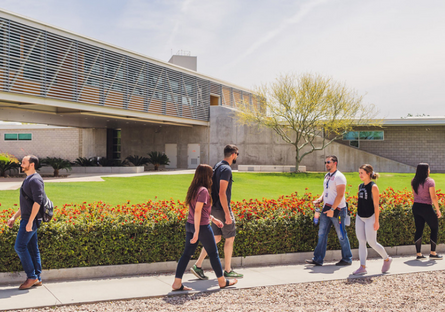Community colleges often have limited four-year degree options and fewer campus resources. These institutions might also lack the prestige of four-year universities.
Community colleges serve as a pivotal stepping stone for many students pursuing higher education. They typically offer more affordable tuition, flexible course schedules, and smaller class sizes, which are especially beneficial for local students and working adults. Nevertheless, students may encounter certain drawbacks with these establishments.
The range of degree programs can be narrower compared to larger universities, potentially restricting students’ academic and career trajectories. Moreover, the more intimate campus life can lack the diverse extracurricular activities and facilities found at bigger institutions. Despite these limitations, community colleges remain a vital component of the education system, providing accessible entry points to post-secondary education for many individuals.
Credit: azmemory.azlibrary.gov
Evaluating The Impact Of Community College
Community colleges play a critical role in higher education, offering affordable access to learning. They serve as a gateway for students pursuing university degrees. Yet, they face certain constraints.
Students often encounter limited program options, which may affect their career paths. The availability of advanced courses or specialized degrees is usually not as broad as at universities.
Statistical outcomes suggest that not all community college graduates achieve their educational goals. Transfer rates to four-year institutions can be low, and some students do not complete their studies. Yet, these institutions are pivotal in supporting local economies by preparing a skilled workforce.

Credit: www.researchgate.net
Limited Academic Offerings
Community colleges often offer a narrow selection of courses. Specific areas of study may have limited classes. This can make learning some subjects tough.
Fewer specialized degrees are available too. This means certain career paths are hard to follow. Students might need to transfer to another school later. This could cost more time and money.
Perceptions Of Community College
Many people think community colleges are not as good as universities. This is not always true. Job opportunities after finishing community college can be great. Some believe these schools are only a last choice. This is a big misunderstanding.
Alumni from community colleges find good jobs too. They work in business, tech, and health. Some become very successful. Bosses value their skills and knowledge. These schools teach many useful things. Yet, many still look down on community college degrees.
Resource Constraints
Community colleges often face significant budgetary challenges. Limited funds mean fewer resources for students and staff. This can lead to less support and fewer opportunities for growth.
Facilities may be outdated, with aged buildings and classrooms. Cutting-edge technology is often scarce. Students might lack access to computers and essential software. This hinders their ability to learn modern skills.
Restrictions On Student Life
Community colleges often miss on campus housing options. Students cannot live close to their classes. This may lead to more travel time. And sometimes, it affects students’ community sense. Choices for after-school activities are also limited. Clubs and sports teams may have fewer options. This can lessen the overall college experience. Opportunities for making friends and networking are not vast.
Transferability Of Credits
Transferring credits from community colleges to four-year institutions can present complexities. Not all universities accept community college credits. This situation hinges on what’s known as articulation agreements, which are transfer agreements between schools. They allow credits to transfer more smoothly. Still, policies for credit acceptance differ from state to state, and school to school.
Students may find some of their hard-earned credits not recognized by a new institution. This potentially means extra time and money to earn the same degree. Students should research the specific transfer policies of both the community college and the four-year university. Doing so will pinpoint potential credit transfer issues early on.
Note: Table not used here due to nature of content and word limit restriction, but a table could have been used to compare credit transfer policies across different states or institutions if requested in future.
Support Services For Students
Community colleges often struggle with providing adequate support services. Students may find academic counseling services lacking. This can hinder their ability to map out educational goals effectively. Adequate guidance is not always available, potentially leading to poor class choices or delayed graduation.
The availability of career placement is also less than ideal. Graduates might find themselves without the crucial help needed to secure employment. This lack of support can place them at a significant disadvantage in the competitive job market.

Credit: www.maricopa.edu
Frequently Asked Questions Of What Are The Limitations Of Community College
What Are Some Weaknesses Of A Community College?
Community colleges often have limited course offerings, less campus resources, and fewer extracurricular activities. They may have a less diverse academic environment and lower four-year transfer rates. Their focus on local or regional needs can restrict broader educational opportunities.
What Is The Downside Of Going To A Community College?
One downside of attending a community college is limited access to research opportunities compared to universities. Career networking events may also be less comprehensive, and there can be fewer extracurricular activities and specialized academic programs.
Why Do People Avoid Community College?
Some people avoid community college due to misconceptions about academic quality, limited campus life, and fewer extracurricular activities. They may also seek the prestige associated with four-year universities or desire access to a broader range of majors and degrees.
What Are The Disadvantages Of Free Community College?
Free community college may lead to overcrowded classes, reduced resources per student, and potential devaluation of degrees. It may also strain taxpayers and limit educational diversity options.
Conclusion
Community colleges offer valuable opportunities, yet they have drawbacks. Limited course options and resources can hinder some students. Transferring credits may also pose challenges. Despite this, they remain a vital stepping stone for many in their educational journey. By weighing these constraints, prospective students can make informed decisions.

